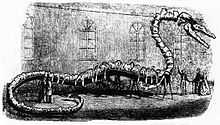Pontogeneus
| Pontogeneus Temporal range: Late Eocene | |
|---|---|
| Scientific classification | |
| Kingdom: | Animalia |
| Phylum: | Chordata |
| Class: | Mammalia |
| Order: | Cetacea |
| Suborder: | Archaeoceti |
| Family: | Basilosauridae |
| Genus: | Pontogeneus Leidy, 1852 |
| Binomial name | |
| Pontogeneus priscus Leidy, 1852 | |
Pontogeneus (nomen dubium)[1] is a genus of extinct cetacean known from fossils recovered from Late Eocene sediments (Bartonian-Priabonian stages) of the southeastern United States.
Classification
When "Zeuglodon" brachyspondylus was formerly included, Pontogeneus was depicted as having a skeleton similar to that of Basilosaurus cetoides, although the posterior thoracic vertebrae, the lumbar vertebrae, and the anterior caudal vertebrae had proportions closer to those seen in members of the archaeocete Subfamily Dorudontinae.

Taxonomic history
In 1852, Joseph Leidy had erected Pontogeneus priscus based on the centrum of a single cervical vertebra in the collections of the Academy of Natural Sciences in Philadelphia. Leidy noted that the centrum had been collected from exposures along the Washita River in Louisiana. Kellogg 1936 synonymized these two taxa to form Pontogeneus brachyspondylus which he listed as incertae cedis.[2]
Uhen 2005 designated Pontogeneus priscus and Zeuglodon brachyspondylus to be nomina dubia based on the lack of diagnostic characters that distinguish the type specimens from other basilosaurids. While Pontogeneus priscus is no longer considered valid, "Z." brachyspondylus appears similar to Masracetus from Egypt (which was also referred to Z. brachyspondylus in the past) and may represent either a species of Masracetus or a distinct and closely related but as-yet-unnamed genus.[3]
Formerly assigned to Pontogeneus
"Zeuglodon brachyspondylus" (Müller 1849) was erected for several vertebrae collected in either Choctaw or Washington counties in southern Alabama.
Basilosaurid remains from Egypt were tentatively assigned to "Zeuglodon brachyspondylus" based on superficial similarities to the syntype series (under the old hypothesis of synonymy of Pontogeneus and Zeuglodon brachyspondylus).[4] However, these remains were given their own genus, Masracetus, given minor differences from "Z." brachyspondylus.[3]
Notes
- ↑ Basilosauridae in the Paleobiology Database. Retrieved April 2013.
- ↑ Kellogg 1936, p. 248
- ↑ 3.0 3.1 Gingerich, Philip D (2007). "Stromerius nidensis, new archaeocete (Mammalia, Cetacea) from the Upper Eocene Qasr El-Sagha Formation, Fayum, Egypt". Contributions from the Museum of Paleontology 31 (13): 363–78. OCLC 214233870.
- ↑ Stromer, Ernst, 1908. Die Archaeoceti des ägyptischen Eozäns. Beiträge zur Paläontologie und Geologie Österreich-Ungarns und des Orients, Vienna, 21: 106-178.
References
- Jones, D. E. (1989). "Doctor Koch and his "Immense Antediluvian Monsters"". Alabama Heritage 12: 2–19. Retrieved April 2013.
- Kellogg, R. (1936). A review of the Archaeoceti (PDF, 46 MB). Washington: Carnegie Institution of Washington. OCLC 681376. Retrieved July 2013.
- Müller, J. P. (1849). Über die fossilen Reste der Zeuglodonten von Nordamerika mit Rücksicht auf die europäischen Reste aus dieser Familie. Berlin: Reiner. pp. 1–38. OCLC 422134028. Lay summary.
- Thewissen, J.G.M., ed. (1998). The Emergence of Whales: Evolutionary Patterns in the Cetacea. Plenum Press. ISBN 9780306458538.
- Thurmond, J.T.; Jones, D.E. (1981). Fossil Vertebrates of Alabama. University of Alabama Press. OCLC 6144344.
- Uhen, M. D. (2005). "A new genus and species of archaeocete whale from Mississippi". Mississippi Geology 43 (3): 157–172.